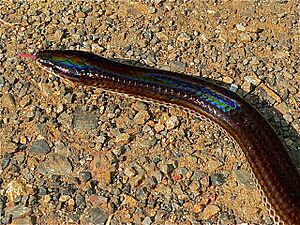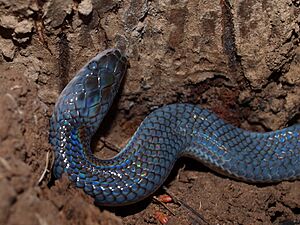Sunbeam snake facts for kids
Quick facts for kids Sunbeam snake |
|
|---|---|
 |
|
| Khao Yai National Park, Thailand | |
| Conservation status | |
| Scientific classification | |
| Genus: |
Xenopeltis
|
| Species: |
unicolor
|
| Synonyms | |
|
|
The sunbeam snake, also known as the common sunbeam snake or iridescent snake, is a fascinating snake found in Southeast Asia and parts of Indonesia. This snake is not venomous, meaning it does not have poison. It is famous for its super shiny, rainbow-like scales. It can also lay many eggs at once, up to 10!
Description
Sunbeam snakes usually grow to be about 1 meter (3 feet 3 inches) long. They are fossorial animals, which means they spend most of their lives digging and living underground. Their head is shaped like a wedge and is narrow, helping them push through soil easily.
The most special thing about these snakes is their iridescent scales. These scales are very shiny and polished, making them look like a rainbow in the sunlight. This is how they got their name! Each scale has a dark layer just underneath its surface. This layer helps to make the rainbow effect even stronger.
Young sunbeam snakes look a lot like the adults. However, they have a bright white "collar" of scales right behind their head. This white color fades away during their first year of life. These snakes can also see colors, which is called dichromatic color vision.
Where They Live
You can find sunbeam snakes in many places across Asia. They live in China (in Guangdong and Yunnan), Myanmar, the Andaman and Nicobar Islands, Vietnam, Laos, Cambodia, Thailand, West Malaysia, Penang Island, Singapore Island, and East Malaysia (Sarawak). They are also found in Indonesia (including the Riau Archipelago, Bangka, Billiton, Sumatra, We, Simalur, Nias, the Mentawai Islands [Siberut], Borneo, Java and Sulawesi). In the Philippines, they live on Balabac, Bongao, Jolo and Palawan islands.
Habitat
Sunbeam snakes like to live in open areas. You might find them in forest clearings, gardens, and parks. They are also often seen in rice fields.
Behavior
These snakes are constrictors. This means they wrap their strong bodies around their prey and squeeze them. This helps them catch their food.
As mentioned, they are fossorial and spend most of their time underground. If you pick them up roughly, they might bite. However, they usually try to escape if they feel threatened. When they are scared, they might also vibrate their tails, much like a rattlesnake does.
Feeding
Sunbeam snakes eat a variety of foods. Their diet mainly includes frogs, other reptiles (even other snakes), and small mammals.
Reproduction
Sunbeam snakes are oviparous. This means the females lay eggs. They can lay up to 10 eggs at one time.



